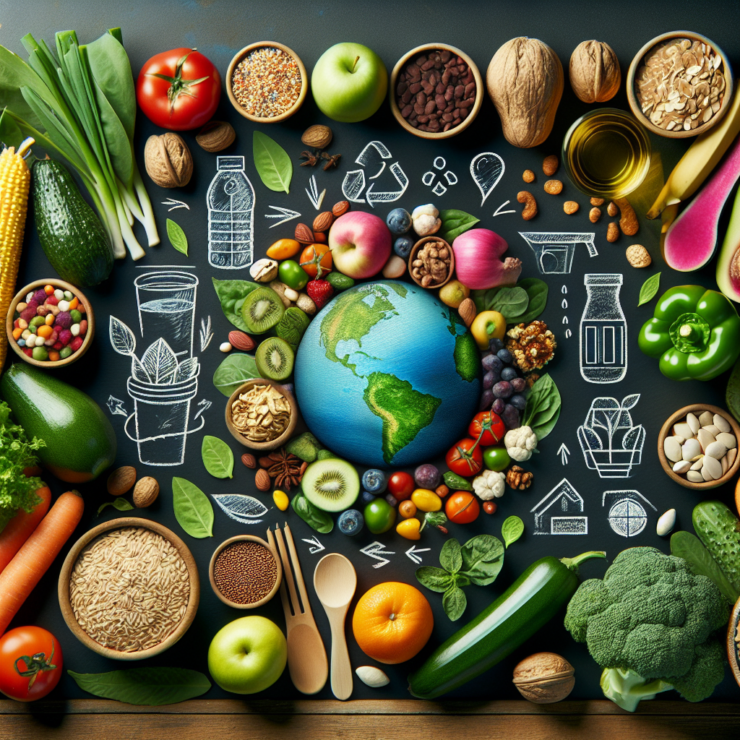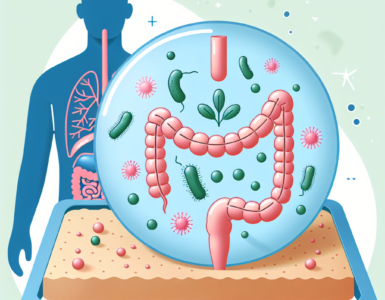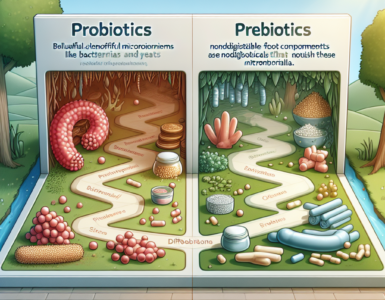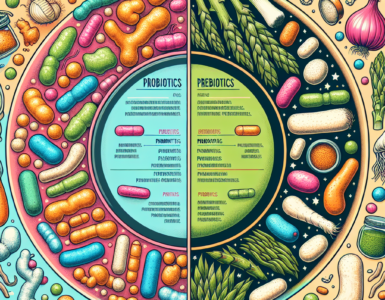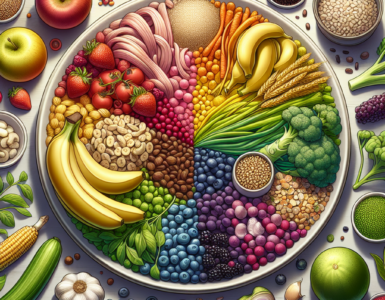Introduction to Sustainable Eating
What is Sustainable Eating?
Sustainable eating is a dietary approach that prioritizes the long-term health of both the planet and its inhabitants. It encompasses choosing foods that are not only nourishing but also have a minimal environmental footprint. This approach to nutrition involves considering the entire lifecycle of food products — from the methods used in farming and production to transportation, packaging, and ultimate disposal.
At its core, sustainable eating is about making choices that support the conservation of resources, reduction in pollution, and the maintenance of biodiversity. It includes being mindful of how food consumption affects the world’s ecosystems and striving to make decisions that contribute positively to the environment.
Why Make Sustainable Food Choices?
Making sustainable food choices is becoming increasingly important in a world facing environmental challenges such as climate change, soil degradation, and water scarcity. These choices can lead to significant positive outcomes for the planet, including:
- Reducing Greenhouse Gas Emissions: The food system is a major contributor to global greenhouse gas emissions. By choosing sustainable options, individuals can help lower their carbon footprint.
- Conserving Natural Resources: Sustainable eating often involves reducing meat consumption and opting for plant-based foods, which typically require fewer resources like water and land to produce.
- Supporting Local Economies: Purchasing food from local sources not only reduces transportation emissions but also supports local farmers and producers.
- Promoting Animal Welfare: Sustainable diets often consider the conditions in which animals are raised, opting for sources that practice ethical treatment of livestock.
- Improving Health: Many sustainable food choices are also healthier, being less processed and lower in additives.
The motivation to make sustainable food choices is not only about environmental stewardship but also about making conscientious decisions that can lead to healthier lifestyles for individuals and communities.
| Reasons to Make Sustainable Food Choices | Benefits |
|---|---|
| Reducing Greenhouse Gas Emissions | Lower Carbon Footprint |
| Conserving Natural Resources | Preservation of Water and Land |
| Supporting Local Economies | Strengthening Local Agriculture |
| Promoting Animal Welfare | Ethical Treatment of Animals |
| Improving Health | Consumption of Nutrient-Rich Foods |
The transition to sustainable eating is an opportunity for individuals to contribute to a more resilient food system and a healthier planet. It is a collective effort that starts with personal choices made every day, at every meal.
Principles of a Sustainable Diet
Adopting a sustainable diet involves understanding the interconnectedness of our food choices and the environment. It’s not just about what we eat, but also how our food is produced, processed, and transported.
Understanding Food’s Environmental Impact
The environmental impact of food production is vast and multifaceted. It encompasses various elements including greenhouse gas emissions, water and land use, energy consumption, and the use of chemicals in farming. Here, we take a closer look at how different food choices can influence these factors.
| Food Category | Greenhouse Gas Emissions (CO2 eq per kg) | Water Usage (liters per kg) |
|---|---|---|
| Beef | 27.0 | 15,415 |
| Cheese | 13.5 | 5,060 |
| Rice | 2.7 | 2,497 |
| Vegetables | 0.5 | 322 |
By examining this data, it becomes evident that certain food groups, particularly animal-based products, have a higher environmental footprint compared to plant-based options. Making mindful choices, such as reducing meat consumption, can significantly lessen one’s ecological impact.
The Importance of Biodiversity and Ecosystems
Biodiversity is the variety of life on Earth, including the different species of plants, animals, and microorganisms, the genetic differences within these species, and the ecosystems they form. Healthy ecosystems and rich biodiversity are fundamental to life on our planet. They provide us with food, clean water, air, and many other services that support human life and well-being.
| Ecosystem Service | Benefits |
|---|---|
| Pollination | Essential for the production of fruits, nuts, and seeds |
| Soil Fertility | Crucial for plant growth and agriculture |
| Water Purification | Natural filtration systems for clean water |
Sustainable food choices often promote agricultural practices that support biodiversity, such as organic farming, which avoids the use of synthetic pesticides and fertilizers that can harm wildlife and pollute water sources. By choosing foods from systems that prioritize ecological balance, individuals contribute to the preservation of biodiversity and the health of ecosystems.
Key Components of Sustainable Food Choices
Embarking on the journey of sustainable eating involves understanding the core aspects that make a diet eco-friendly. These components work in tandem to reduce one’s carbon footprint and promote a healthier ecosystem.
Seasonal and Local Eating
Seasonal and local eating is vital to sustainable food choices. Consuming foods that are in season and grown locally reduces the environmental impact associated with long-distance transportation, including lower greenhouse gas emissions and less packaging waste. It also supports local economies and can provide more nutrient-rich produce due to shorter times between harvest and consumption.
| Season | Common Seasonal Produce |
|---|---|
| Spring | Asparagus, Strawberries, Peas |
| Summer | Tomatoes, Corn, Melons |
| Fall | Apples, Squash, Pears |
| Winter | Citrus fruits, Root vegetables, Kale |
Organic and Non-GMO Foods
Organic foods are cultivated without the use of synthetic pesticides, fertilizers, or genetically modified organisms (GMOs), all of which can have detrimental effects on the environment. By choosing organic and non-GMO products, individuals can support farming practices that are more in harmony with nature, promote biodiversity, and reduce the chemical load in the soil and water.
| Benefits | Organic | Non-GMO |
|---|---|---|
| Pesticide Use | Reduced/None | Varies |
| Environmental Impact | Lower | Potentially Lower |
| Soil Health | Improved | Varies |
Plant-Based Diets and Reducing Meat Consumption
A plant-based diet, which emphasizes fruits, vegetables, grains, nuts, and seeds, has a significantly lower environmental impact compared to diets high in meat and dairy. The production of plant-based foods generally requires less water, land, and energy, and it generates fewer greenhouse gases. Reducing meat consumption, especially red and processed meat, can be a powerful step toward a sustainable diet.
| Diet Type | Greenhouse Gas Emissions (kg CO2-equivalents per kg) |
|---|---|
| Plant-based | 0.5 – 1.7 |
| Chicken | 6.9 |
| Pork | 12.1 |
| Beef | 27.0 |
By integrating these key components into one’s lifestyle, individuals can actively participate in the movement toward a more sustainable future. Seasonal and local eating, organic and non-GMO food choices, and a plant-based diet are all ways in which one can make a positive impact on the environment through their daily meal decisions.
Strategies for Implementing a Sustainable Diet
Adopting a sustainable diet involves intentional choices and practices. It’s not just about what individuals eat, but also how they plan, prepare, and consume food. Here we explore effective strategies for integrating sustainable food choices into everyday life.
Planning and Preparing Sustainable Meals
To ensure one’s meals are as sustainable as possible, planning ahead is key. This involves:
- Selecting recipes based on seasonal and locally available ingredients.
- Planning meals for the week to minimize grocery store trips and impulse buys.
- Preparing and storing food in a way that maximizes its shelf life.
One can begin by creating a meal plan template that emphasizes plant-based ingredients and incorporates local, organic, and non-GMO products where possible. By doing so, individuals can make a positive impact on the environment and their health.
| Day | Meal | Main Ingredients | Source |
|---|---|---|---|
| Monday | Dinner | Local squash, organic quinoa | Farmers market, Organic store |
| Tuesday | Lunch | Seasonal salad with leafy greens | Community garden, Local farm |
Utilizing such a meal plan ensures that individuals are not only eating sustainably but also supporting local producers and reducing the carbon footprint associated with food transportation.
Reducing Food Waste
Food waste is a significant issue with both economic and environmental implications. Strategies to reduce food waste include:
- Buying only what is needed, based on the meal plan.
- Properly storing foods to preserve freshness.
- Getting creative with leftovers instead of discarding them.
An effective way to track and minimize food waste is by keeping a waste log. This log can help identify patterns and areas for improvement in food usage.
| Week | Food Wasted | Reason | Preventative Measure |
|---|---|---|---|
| 1 | 2 apples | Overripe | Buy fewer apples next time |
| 2 | 1 cup of rice | Cooked too much | Measure portions accurately |
By maintaining awareness and making small adjustments, individuals can significantly reduce their food waste, thus contributing to a more sustainable food system.
Implementing a sustainable diet is a multifaceted endeavor that involves thoughtful planning and a commitment to reducing waste. By embracing these strategies, individuals can make a meaningful contribution to a greener lifestyle and a healthier planet.
Challenges and Considerations
Adopting sustainable food choices is an admirable goal, yet it comes with its own set of challenges and considerations. Two of the most significant hurdles are the cost of sustainable eating and the accessibility and availability of sustainable food options.
The Cost of Sustainable Eating
One common perception is that sustainable eating is more expensive than conventional eating habits. Organic and sustainably-sourced foods often come with a higher price tag due to more labor-intensive farming practices, stricter regulations, and the absence of subsidies that benefit large-scale conventional farms.
Here is a comparison of average costs for conventional versus organic produce:
| Food Item | Average Cost: Conventional (USD) | Average Cost: Organic (USD) |
|---|---|---|
| Apples (per lb) | 1.32 | 1.65 |
| Spinach (per bunch) | 2.14 | 2.99 |
| Chicken Breast (per lb) | 3.18 | 6.36 |
The table indicates a clear difference in cost, which can be a barrier for some individuals and families. However, investing in sustainable food choices can be seen as an investment in personal health and environmental well-being. Consumers may find that the benefits outweigh the costs in the long run.
Accessibility and Availability
Accessibility to sustainable food options is another challenge faced by many. Individuals living in urban areas or food deserts may find it difficult to source sustainable products. Geographical location can significantly impact the variety and availability of sustainable food choices.
The following list outlines the availability of sustainable food options in different settings:
- Urban Areas: May have access to farmers markets and specialty stores but can lack community-supported agriculture (CSA) programs.
- Suburban Areas: Might experience a mix of accessibility to supermarkets with organic sections and local farms.
- Rural Areas: Often have direct access to farms but may lack variety found in larger markets.
Efforts to increase accessibility include the expansion of farmers markets, the development of mobile markets, and the implementation of policies that support local food initiatives. Community gardens and urban agriculture projects are also effective ways to enhance local access to sustainable foods.
In summary, while there are challenges to implementing a sustainable diet, understanding these obstacles is the first step towards overcoming them. Recognizing the cost implications and working towards improving the accessibility and availability of sustainable food choices are essential for those aiming to make eco-friendly dietary changes.
Impact of Sustainable Eating
Sustainable eating is not just a dietary choice; it’s a commitment to making a positive impact on the world. The repercussions of this lifestyle extend far beyond one’s personal health, influencing both the environment and the well-being of society as a whole.
Benefits to the Environment
Sustainable food choices significantly benefit the environment in several ways. By reducing the demand for resource-intensive foods, there is a corresponding decrease in the use of water, land, and energy. Moreover, sustainable eating habits can lead to a substantial reduction in greenhouse gas emissions, which are a major contributor to climate change.
| Environmental Aspect | Impact of Sustainable Eating |
|---|---|
| Greenhouse Gas Emissions | Reduction of up to 50% for plant-based diets compared to meat-heavy diets |
| Water Usage | Decrease in water footprint by choosing crops with lower water requirements |
| Land Use | More efficient land use and reduced deforestation with sustainable farming practices |
Furthermore, sustainable eating supports biodiversity by promoting the growth of a variety of crops, which helps to maintain healthy ecosystems. This diversity also contributes to soil health and the reduction of pollution due to decreased reliance on chemical fertilizers and pesticides.
Health Benefits of Sustainable Food Choices
Adopting sustainable food choices can also have a profound effect on one’s health. Foods that are produced sustainably are often more nutritious, containing a higher density of vitamins and minerals. A diet rich in plant-based foods, which is a cornerstone of sustainable eating, has been linked to a decreased risk of chronic diseases such as obesity, heart disease, and type 2 diabetes.
| Health Aspect | Impact of Sustainable Eating |
|---|---|
| Chronic Disease Risk | Lower incidence of heart disease, obesity, and type 2 diabetes with high plant-based food intake |
| Nutrient Intake | Increased consumption of essential nutrients such as fiber, vitamins, and minerals |
Apart from the physical benefits, sustainable food choices can also lead to improved mental well-being. Studies have suggested a correlation between diets high in fruits and vegetables and a lower risk of depression and anxiety.
By making sustainable food choices, individuals not only invest in their own health but also contribute to the welfare of the planet. These choices can foster a more resilient food system, reduce environmental damage, and establish a healthier, more equitable world for future generations.
Taking Action Beyond the Plate
Adopting sustainable food choices involves more than just what we eat. It extends to how we support the broader food systems and engage with our communities to promote environmental health. Individuals can play a dynamic role in fostering a more sustainable world through supporting sustainable food systems and participating in advocacy and community engagement.
Supporting Sustainable Food Systems
To support sustainable food systems, individuals can contribute in various ways. One approach is to invest in community-supported agriculture (CSA) programs. These programs allow consumers to purchase shares of a farmer’s harvest in advance, providing farmers with upfront capital to manage their operations.
Another approach is to frequent farmers’ markets, which not only bolsters the local economy but also reduces the carbon footprint associated with transporting food over long distances. Moreover, engaging with food cooperatives that prioritize sustainable practices can encourage conventional retailers to adopt similar practices.
| Action | Description | Potential Impact |
|---|---|---|
| Joining a CSA | Purchasing a share of a local farm’s harvest. | Direct financial support to sustainable farming. |
| Shopping at Farmers’ Markets | Buying locally produced food. | Reduced transportation emissions. |
| Participating in Food Co-ops | Engaging with cooperatives that sell sustainably sourced products. | Encouraging sustainable practices in the food industry. |
These actions not only support the sustainability of food systems but also often lead to the discovery of a diverse array of foods that one might not encounter in a conventional supermarket.
Advocacy and Community Engagement
Advocacy and community engagement are crucial for creating systemic change. Individuals can advocate for policies that support sustainable agriculture, such as subsidies for organic farming or regulations on food waste. By contacting local representatives, signing petitions, and participating in public meetings, citizens can influence policy decisions that shape the food system.
Engaging with the community through educational programs and workshops can also spread awareness about the benefits of sustainable eating. Volunteering with local environmental groups or organizing community garden projects can help to foster a culture of sustainability within local neighborhoods.
| Engagement Type | Description | Expected Outcome |
|---|---|---|
| Policy Advocacy | Promoting policies that support sustainable agriculture. | Influence policy for a more sustainable food system. |
| Educational Outreach | Conducting workshops about sustainable eating. | Increased community awareness and adoption of sustainable practices. |
| Community Gardening | Participating in or organizing local garden projects. | Enhanced food access and community resilience. |
Through these strategies, individuals not only contribute to the sustainability of their own diets but also help to build a more robust and environmentally friendly food system for the community and beyond. By taking action beyond the plate, each person can be a catalyst for positive change, paving the way toward a greener lifestyle and a healthier planet.


